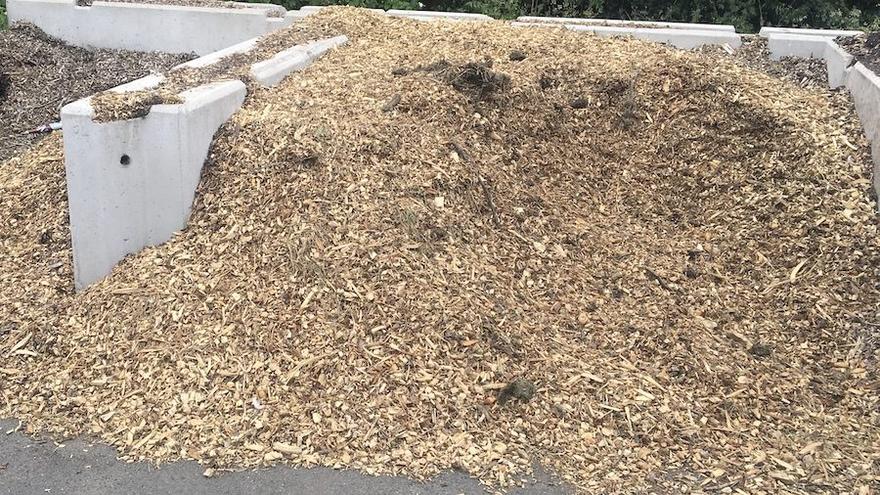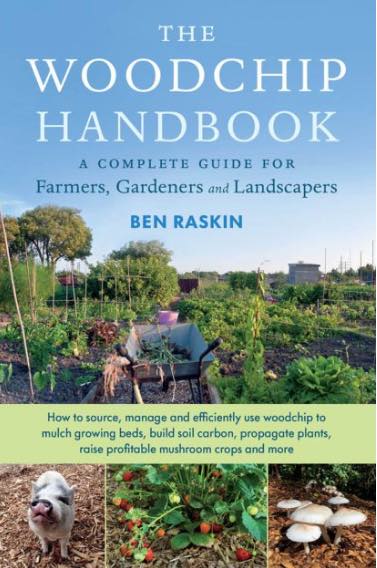Using woodchip in container growing

Woodchip makes an excellent mulch for fruit trees in containers - to suppress weeds and to help retain water. It can also be used to make homemade compost, to add structure to worm compost, and even to grow mushrooms. It's a sustainable resource, a waste product of pruning trees and fallen branches. It can sometimes be found at low cost or even free. And it's often widely available in urban areas (look out for tree surgeons!) - although you may need to scout around to find a supply.
 Ben Raskin author of the Woodchip handbook
Ben Raskin author of the Woodchip handbook
I chatted recently with woodchip expert, Ben Raskin. Ben is Head of Horticulture at the Soil Association, and author of the Woodchip Handbook. Our conversation focuses on the different ways to use woodchip in container growing. You can listen to the podcast and find a summary of the main points below. This is part of a new series of posts and podcasts on the theme of 'Small Space Pioneers', exploring how to create healthy and abundant edible gardens using sustainable, local resources.
How to use woodchip as a mulch on containers
A mulch is a layer of material, added to the surface of the soil to help retain water and suppress weeds.
Woodchip makes an excellent mulch, particularly for fruit trees in larger containers. It will help to retain water, reducing water needs by up to 25%. Fresh woodchip will also suppress weeds (composted woodchip will be less effective). Research shows that some woodchip mulches (particularly willow) can also help prevent diseases.
But occasionally woodchip can carry disease from its parent plant. This is rare and the benefits usually far outweigh the risk. It can be minimised by avoiding direct contact between the woodchip and the stem of the fruit tree.
Ben suggests that fresh woodchip mulches are better suited to larger pots. In small pots, it is possible that fresh woodchip will be detrimental to plant growth by taking nitrogen from the soil. (Plants need nitrogen for strong growth.) However composted woodchip (see below) can normally be safely used on small pots, too.
Most vegetables can also be mulched successfully with composted woodchip and larger crops like squash and courgettes / zucchini with fresh woodchip. Ben recommends being more careful about mulching shallow rooted crops like tomatoes with fresh woodchip. It's worth experimenting - and keep a watchful eye on them and remove the mulch if any detrimental signs appear
Composting woodchip
Woodchip can be used fresh as mulch (see above) or composted to make a seed compost, potting mix or to add structure to old compost. It is simple to compost. Simply leave it in a pile or in a bin or bag for 12 to 24 months until it breaks down. When it smells earthy and the chips have mainly broken down, it is ready to use. If using as a seed compost, you may want to sieve any large bits out.
Making seed compost and potting compost
Experimental farmers are finding that well rotted woodchip makes an excellent seed compost. In trials it has performed as well as top seed compost brands. Composted woodchip can also be used to make a potting compost for larger plants. It doesn't contain a lot of nutrients so needs to be mixed with something like home made compost or worm compost.
During - and as part of - the early composting process Ben says it is possible to grow mushrooms on the woodchip. As it becomes more rotted down, it's then feasible to grow squash and courgettes, before using it for other crops. This sounds like an exciting and fun way to get a lot out of one batch of woodchip! I'd love to hear from anyone who tries this.
Making worm compost
When made with food waste (for greens) and cardboard or paper (for browns), worm compost can be somewhat squidgy and lacking in structure. In my experience, adding in a few handfuls of woodchip helps to improve the structure of the compost and the air flow within the wormery. It's an aerobic process so this is a good thing.
The safest option is to add composted woodchip to wormeries - or at least partially composted woodchip. There is some debate about adding fresh woodchip. Ben has heard that it's not recommended (and I've heard advice not to add fresh pine woodchip), but he has also observed worms happily moving into fresh woodchip. If you have experience using woodchip in a wormery, it would be great to hear from you in the comments.
Where to find woodchip and what sort to use?
Woodchip is a waste product produced by tree surgeons. They will sometimes sell you or give you a trailer load. However, demand for woodchip is growing as more people learn about its benefits (and with the phasing out of peat) and finding free sources is getting harder. It is also harder to get woodchip in small, bag size quantities.
Does it matter what sort of tree make up the woodchip? Try to avoid 100% pure conifer if you can (when fresh, it contains chemicals that may inhibit plant growth). But anything up to about 30% conifer is usually fine. 100% conifer woodchip is also OK to use if it has been well composted first.
Allotments and community growing projects often get large deliveries of woodchip. It's worth asking around as they may be happy for you to take or buy the odd bag for your container garden. This is a great solution if you find it. Wood chip can also be purchased in bags from garden centres. Although not the cheapest way to get it, this is sometimes the easiest and most convenient solution.
In the UK, I occasionally buy bags of Melcourt composted bark. Already composted, it can be added straight to wormeries without any worry, and I find it excellent. It can also be added to old compost to help improve its structure.
Ben's Book
While Ben's book is aimed more at larger scale growing than container growers, it's a useful resource for anyone wanting to learn more about woodchip. I really enjoyed reading it and learnt a lot.

Your Turn
We are in the realms of experimental growing here, not all the ideas here are tried and tested in container growing! If you've used woodchip in containers, I'd love to hear about your experience in the comments below to help us learn together.

2 comments
Leave a comment